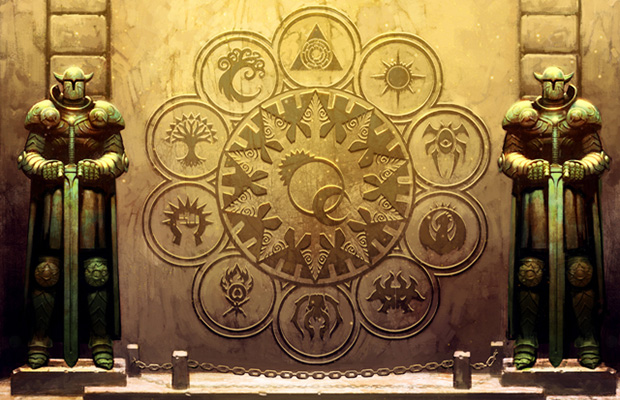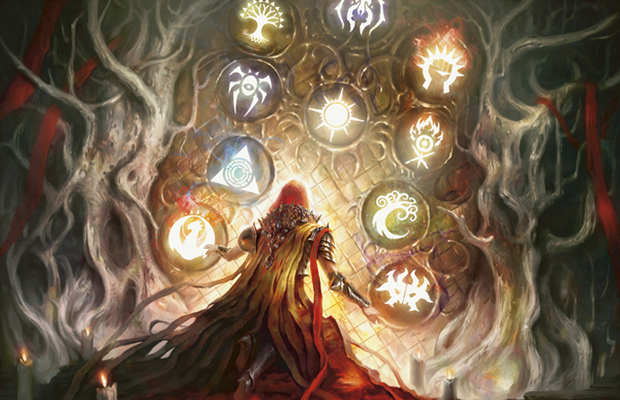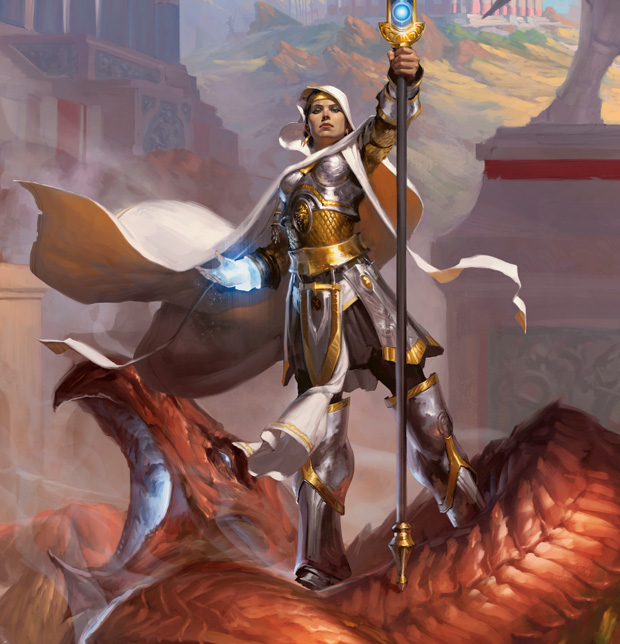State of Design 2013
Every year since I became head designer, I dedicate a column looking back at the previous year's worth of designs and take a critical look at how we did. This State of Design column is based off an annual speech given by the US president called the State of the Union. I choose to do this every year because I want to be very open with our design and talk about what went right and what went wrong. I also use this column to set some goals for the year ahead. This is my ninth State of Design column. Here are my previous eight: 2005, 2006, 2007, 2008, 2009, 2010, 2011, and 2012.

I start every year by answering the same question: How was the last year for Magic design? If I had to give it a letter grade, I'd give it a B+. We executed well on the guilds, improving upon the vast majority of them from the first go-round. We introduced an entirely new block structure in Large/Large/Small, which did fundamentally change how the block was used and perceived. We made a lot of good cards and mechanics that our audience enjoyed. As a result of all of this, last year was our best-selling year in the game's history. Many games of Magic were played and much fun was had.
But here's the thing, I don't aim for a B+; I always aim for an A. What that means is that while there were many successes this year, there was also some room for improvement. So what kept Return to Ravnica block from being an A? The simplest answer is that I don't think we innovated enough for my tastes. We revisited Ravnica but we didn't reinvent Ravnica.
Now, if ever there was a set to be conservative on, this was the one. We were returning to one of the most popular planes of all time, so there was a lot of pressure to recapture the world players had loved as they had loved it. In reflection, I just wish I had been a little more adventuresome in how we approached this block.
How was the last year for Magic design? It was good—very good, in fact—but as head designer, I'm never totally satisfied if it wasn't great.
Let's now move from the big picture to the details. Here are the highs and lows of 2012/2013.
- Highlights of 2012/2013
We Hit Guilds Out of the Park
The secret sauce of the original Ravnica block was the guilds. We spent a lot of time making sure the feel of each guild came through not just with the creative elements, but with the game play as well. Upon our return, the focus of our design was likewise on the guilds and that was the area the design excelled at. We knew the guilds were what players loved the first time around so we doubled down on them for the return.

This was one of the design areas where I felt we excelled. Each guild had a mechanic that both captured the feel of the guild and played well mechanically with the previous incarnation of that guild. (I do have a few areas for improvement, but I'll get to those below.)
I thought our guild mechanics were in most cases better than the guild mechanics of the original Ravnica block. Whereas the original Ravnica block only had a handful of mechanics I expect to do again, I feel the vast majority of Return to Ravnica block's mechanics will be revisited.
The other thing I was really happy with is that each guild had both a Limited and Constructed identity that, while not always the same, both played into the core ethos of the guild.
The Block Structure
The block did, in fact, have one big innovation and it was one of the strongest things about the block. When I had originally planned to return to Ravnica, the idea was to repeat the Large/Small/Small 4/3/3 structure, just mixing up the order of the guilds. Brian Tinsman, though, was intent of finding a way to make 5/5/10 work, which led me to suggest the idea of doing a Large/Large/Small structure.
There were a number of things I enjoyed about this block structure:
- It allowed every guild the opportunity to be drafted. In the original Ravnica block, only the four guilds in the first set (Boros, Dimir, Golgari, and Selesnya) ever got that chance.
- The new structure allowed each set to have its own unique draft, where each set created a new draft environment fundamentally different from the other two.
- While they later would get time to mingle, each of the large sets got some time to have focus on just itself. Normally, only the first set (and sometimes the third) ever gets this luxury.
- The first set got to take a break and come back later in the block.
I feel like we tried many things for the first time in this block structure, many which went well enough that I plan to revisit it in future block plans.
Interweaving of the Guilds
Of all the nuance in the design, I think my favorite thing was not the design of the individual guilds but rather how we crafted them such that they interweaved so nicely. I love how each guild brought something to the table that could then be used by other guilds.
This was done so that the synergy would first be seen through the monocolor cards in Return to Ravnica and Gatecrash drafts (we were very careful to make sure that each mechanic worked in the adjacent guilds) and then through the multicolor cards when guilds were mixed and matched in the full draft. No matter what two guilds you picked (which, yes, was actually three guilds), they played wonderfully.
- Lessons of 2012/2013
Nitpicks on the Guilds
While I believe we did a great job capturing the feel of the guilds, I feel there was some room for improvement. A few of the highlights:

Izzet—This is the one guild whose essence I don't feel we mechanically captured. Yes, we played into the instants-and-sorceries aspect of the guild, but I feel this guild was too Melvin and not enough Vorthos. The Izzet are relentless inventors making crazy inventions and to me they are the most Johnny of all the guilds, yet I don't feel that quality comes through nearly enough. I wish playing Izzet felt more like being Izzet would feel. I've said many times that I'm an Izzet through and through. The fact that I wasn't that excited to play this guild was a sign that something was off.

Gruul—While I think bloodrush is an interesting mechanic and it plays well, I am not convinced that it's the best match-up for the kind of player who most loves to play Gruul. Gruul tends to be more of a Timmy guild and bloodrush is as Spike a mechanic as they come. As you can see, it matters to me a lot that the fan of the guild enjoys how that guild plays. I don't need every player to love every guild but I want players to love their guilds.

Selesnya—Populate is a tricky mechanic in that it requires both cards that create tokens and cards that then populate them. I wish we had been willing to make more vanilla token makers (cards that just make tokens) of different sizes as well as allow ourselves to push cards that make tokens and had populate at lower rarities. In other words, I feel the mix was a little off. Of my three guild complaints, this is the one that was actually the hardest to accomplish. In general, I did enjoy Selesnya, and I loved populate, but I feel it was a little tricky for most fans of Selesnya to navigate.
I will note that the fact that I'm getting down to such nitty-gritty is a sign that we did a pretty good job.
Gatecrash Limited

There were a number of problems here. First, in an attempt to separate Gatecrash from Dragon's Maze, we made the decision to make Gatecrash faster. I think we succeeded a little too well. The speed of the format made it hard to play some of the slower guilds and lessened some options when playing Limited. Also, it was fast enough that it often didn't allow fun things to happen and I feel that decreased the enjoyment of the Limited play for some players.
The second issue, although tied into the first one, was that the synergies between certain colors were just higher than others. The offshoot of this is that the colors, and thus the guilds, were unbalanced in play.
Dragon's Maze

The biggest problem facing Dragon's Maze was a problem it inherited from the block structure: have all ten guilds and everything that represents while not being too complicated. In the end, I don't think Dragon's Maze pulled this off as well as I had hoped (and there's some chance that such a feat isn't even possible). Feedback shows that it was a bit too complicated for a decent number of players.
Another problem was that Dragon's Maze was supposed to push three-color play in Limited to allow players to mix and match the guilds. It seems this isn't happening quite as much as we hoped. The speed of Gatecrash probably has as much to do with this problem as the design of Dragon's Maze.
- Goal Post
Now that I've talked about the highs and lows of the year in design, it's time to examine how we did on the goals I set out for us last year. As I explain every year, remember that the question isn't "did we attempt the goals?" because, obviously, I always choose goals I know we're going to attempt. The question is "How did the goal do as dictated by player reaction?" Yes, we tried certain things, but were they successful? Did players enjoy them?
2013 Goal #1: Show That We Can Improve Upon What Ravnica Did
Judging this goal has a lot to do with how you want to interpret it. If you look at how we handled the guilds then, yes, I believe we did meet it. I feel the mechanical handling of the guilds overall was a sharp improvement over original Ravnica block. The concept of the guilds carried that block but a lot of the execution, with a modern-day lens, was lacking in many ways. For example, I feel that in the original Ravnica block Boros was a huge miss, Orzhov was overly complicated, and Azorius didn't quite feel as white-blue as one would expect. Return to Ravnica block, on the other hand, pretty much nailed each of the guilds mechanically, with Izzet being the only real miss for me (as noted above—and even then, it captured it in the same way that the first Ravnica block did, meaning it was no worse than the first attempt).
If you look at how we tackled Ravnica with more of a big-picture vantage point by looking at how we reexamined what could be done with it, then in that regard we failed. I mentioned this in the introduction, so I don't have more to say on it here.
That said, I think most people interpreted this goal in the first way rather than the second. The guilds were present and they were better than the last time, as most people expected, and I feel that we delivered on that so I'm going to give us a thumbs up for this goal.
2013 Goal #2: Prove Large/Large/Small Works
I would also give this goal a thumbs up. I think the block structure was one of the big successes of the last year and I definitely feel like we could do a Large/Large/Small structure again. There is some issue with how the structure as a whole set up the last set, but as that's the very next goal, I'm not going to count it against this goal.
This is the one area where we stretched and innovated and I'm very happy that this part of the year's design worked out so well.
2013 Goal #3: Execute Properly on "Sinker"
After two thumbs up, we come to a thumbs down (although a slight thumbs down, as the set did deliver well on many axes). I should also note that a lot of what this goal is about is not just the design of "Sinker"but the overall block structure.
The block structure put a lot of responsibilities on the third set. It had to hit all ten guilds with ten different mechanics, all while trying to offer up something new. It did succeed in many regards and there are plenty of ways to chalk this up as a third thumbs up, but I try to be critical in my State of Design articles and when I dig down deep, I have to admit that this set didn't succeed quite as well as I had hoped.
I need to stress, lest it feel like I'm besmirching the design of Dragon's Maze, that I feel the issue here was much more about how the block was set up—my responsibility—than the design of the set itself.
So two for three. Good but not great. Let's take a look at next year's goals:
2014 Goal #1: Show That We Understand How to do Top-Down Design
Magic has done top-down-designed blocks twice before: Champions of Kamigawa and Innistrad. One was a great success and the other was, well, Champions of Kamigawa. This goal basically asks, "Have we figured out how to do this or was Innistrad just lightning in a bottle?"
Note that succeeding in this goal is not just merely making a popular block but doing one the audience feels captures the inspiration of the source material. As I have and will continue saying, remember that top-down design means we make a Magic world inspired by some real-world source. We are not trying to recreate it but rather use it as a means to make something of our very own shaped by that source. For example, we're not doing the Greek Gods (Zeus, Poseidon, Hades, and such) but rather our versions of gods influenced by the color wheel.
2014 Goal #2: Show That We Can Execute an Enchantment Block

Theros block is very much about top-down design inspired by Greek mythology, but mechanically it is also very much about tapping into the potential of enchantments. One of the goals of design in this block was seeing if we could make enchantments matter but in a way a little different than we've made other things (artifacts, I'm looking at you) matter in the past. This goal asks, "Is this execution interesting?" and even more importantly, "Is this execution fun?"
2014 Goal #3: Show That We Can Reinvigorate a Mechanic
Theros block does something that we haven't done a lot of. We have taken a mechanic that didn't succeed the first time out, given it a make-over (rules tweak, new name and flavor) and are reintroducing it. The big experiment is can we take ideas that we believe didn't live up to their potential the first time out and try again? I very much hope we meet this goal because it's something we have to learn how to do.
Those are the three goals for us to try and meet this year. Check in next year to see how we did.
- Design of the Times
That's all I have for today. I've been a bit critical of this last year's design so I'm eager to see if you agree or disagree. Let me know in my email, in the thread to this column or in any of my social media (Twitter, Tumblr, and Google+).
Join me next week when I finally get to start talking about Theros design as our Theros previews begin.
Speaking of Theros previews, I haven't done one of my set teasers in a while. It's time to correct that mistake. So without further ado, I present:
- Some Teasers from Theros
Let me start by reminding you all that I am only giving you partial information. Everything I'm saying is true but I might be leaving a few things out.
Here are some things you can expect from Theros:
- A 3/3 with three abilities that uses fate counters
- Multiple cards with the word "nongorgon"
- A high-profile cycle of legendary permanents that are not creatures or lands
- A rare card with five words of rules text in which one of the words is "planeswalker"
- An artifact creature that appears to be a big horse made out of wood
- A 5/5 giant snake that can be cast for


- A multicolor Minotaur lord
- A card that could have been in Modern Masters
- A giant that brings fire to humans
- A creature with a saboteur ability (it has an effect if the creature deals combat damage to an opponent) which is one of the Power Nine
Here are a few names of cards you will see:
- Anger of the Gods
- Chained to the Rocks
- Lost in a Labyrinth
- Rescue from the Underworld
- Underworld Cereberus
- Witch's Eye
Finally, here are some of the creatures you're going to see (note that not all of these are creature types and is only a partial list):
- Catoblepas
- Chimera
- Cyclops
- Harpy
- Hippocamp
- Hundred-Handed One
- Kraken
- Nymph (Alseid, Dryad, Lampad, Naiad, and Oread)
- Pegasus
- Satyr
- Siren
- Triton
Hopefully that will give you all a few things to talk about. If, by the way, you care about Theros news, I'd pay attention to social media this weekend, as Magic is throwing a big party at PAX this Saturday.
Once again, join me next week as Theros previews begin.
Until then, may you have the ability to be introspective about what you've recently been up to.
- Drive to Work #48—Scars of Mirrodin, Part 1
Today is the first part of a four-part series on the design of Scars of Mirrodin.
Multi |
- Episode 48: Scars of Mirrodin, Part 1 (12.5 MB)
- Episode 47: Lessons Learned, Part 4 (17.7 MB)
- Episode 46: Instants and Sorceries (12.9 MB)
- Episode 45: Meet My Dad (10.0 MB)
- Episode 44: Making Magic (11.8 MB)
- Complete Drive To Work Podcast Archive



@maro254
Email Mark
Author Archive
Making Magic Archive
Working for Magic Ramp;D since October, 1995, Mark Rosewater is currently the head designer. His hobbies include spending time with his family, talking about Magic on every known medium (including a daily blog and a weekly podcast), and writing about himself in the third person.






